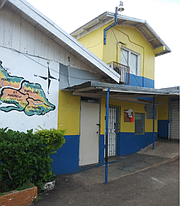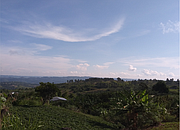‘Of good mind:’ Local teacher recounts time as Peace Corps volunteer in Jamaica
If you want to know Jamaicans better, try their national anthem.
Geri Hagler would know; she just spent a year in that country as part of her volunteer service with the Peace Corps.
“What it is, is actually a prayer,” said Hagler. “It’s about giving and generosity and faith…and trying to be better for all mankind – not just this little country, for all mankind”
The retired sixth-grade teacher was a year into her 27-month service in the Caribbean country when she and 300 other volunteers were suddenly sent home due to COVID-19.
Although her time was cut short, Hagler is “grateful and thankful” for her time in the country.
“They always say it’s the hardest job you’ll ever love,” she said.
“And you will. You’ll love it.”
Established in 1961 by President John F. Kennedy, over 240,000 Americans have volunteered in 142 host nations in the Corps’ history, according to the 2020 Peace Corps fact sheet.
Volunteers with this independent agency of the federal government, “carry out people-to-people public service and citizen diplomacy at the grassroots level.” Working with locals and in-country organizations, they focus on issues of agriculture, economic development, education, environment and health.
Hagler said the application process was difficult and long. After filling out an online application, applicants have to get security clearance and have an interview, usually on Skype. They also work on visa and special passport applications and on obtaining medical clearance.
“Medical clearance is extremely difficult and lengthy… I think the hardest part of the process was sending them everything. I ended up having to spend probably a couple hundred dollars faxing everything.”
Finally, applicants get fingerprinted and fill out aspiration and goals statements.
If successful to this point, volunteers-to-be take a series of online classes and “wait a lot” to find out where they’ll be working.
Peace Corps volunteers often don’t know where they will be placed until shortly before they are set to leave. Even though Hagler had a month’s notice, she knew her destination could be changed up until the day she departed.
After leaving home March 10 of last year, Hagler went to “staging” in Miami to take classes and meet others accepted to Jamaica. Their crew was divided into educational and environmental sectors.
“While we were staging they tried to scare you to death and say ‘This is your last chance to back out now,’ and actually some people did.”
“They wanted to make sure that you’re really going to fulfill [the service] and you’re not going to leave them high and dry.”
After arriving in Jamaica in March 12, there were an additional three months of training and classes. Volunteers learned about the culture, safety and safe practices, and patois – an English Creole language native to Jamaica.
“I can read write and translate patois, but I don’t speak it very well. Me tak like a wally man [I talk like a white person],” she laughed. “No true, no true [It’s true].”
Volunteers live with host families. They pay rent and buy groceries with their Peace Corps earnings to have a better understanding of the local lifestyle. Volunteers follow a curfew and can’t spend the night anywhere. Hagler said she was glad not to be in her 20s like many of the volunteers; following such rules is “no big deal” for someone in their 50s, she said.
Speaking of the local lifestyle, Jamaican culture is very expressive.
“Music is going on all the time in Jamaica,” she said.
“The church is very central. If you want to get to know a community, then you go to church to meet them.”
When describing her experience to friends, Hagler uses the terms “generous” and “warm” to describe the Jamaicans she lived among and had to leave prematurely.
Hagler came to love Ritchies, the town she called home.
“Everybody’s ‘of good mind.’ That’s a Jamaican term,” she said. “That means that you care for your fellow man, and you do what you say you’re going to do, and that you’re generous.”
The rural, agrarian community in the hills that became her home was welcoming of, and generous to, Hagler, particularly after she proved she, too, was of good mind.
“I had to prove I wasn’t an ugly American. I had to show I was of good mind and generous spirit and then I was more accepted.”
This is one of the three missions for Peace Corps volunteers: “To represent Americans to Jamaicans in a positive way… to kind of show them another side of America,” said Hagler.
Likewise, she said she strives to show Americans another side of Jamaicans, pointing out the islanders are often stereotyped as being “Rastas,” a stereotype denoting dreadlocks and the Rastafarian belief system.
This mutual representation is rounded by the Peace Corps’ first mission which forms the bulk of the service: Sending expertise with training/expertise to fill needs for that knowledge in participating countries.
Hagler told stories of protective taxi drivers who would not permit her to walk on busy streets, a stranger letting her know he was “told to watch out for” her, and community members sharing avocados (called ‘pears’ in Jamaica) – after discovering her fondness for them. Although most Jamaicans she met were unfamiliar with the Peace Corps.
She used her experience as a teacher in a Jamaican classroom during her service, helping perform literacy tests and working one-on-one with students who were struggling with their reading. Many of these students had never had this kind of one-on-one attention in school.
“School was very different,” she observed. “It is typical that… classes are separated by rolling chalkboards or rolling boards, so that means that there’s no walls.”
All grade levels are typically being taught at the same time, making the noise level “deafening” at times. Students do a lot of chanting and copying down to learn, and the day is broken up by “devotion” and prayer.
Resources are often scarce in schools, so Hagler – who retired from teaching at Coeur d’Alene Charter Academy - learned to “make fashion,” or make do, creating many of her own teaching materials. She collected bottlecaps and matchbooks to create simple math and word-reading tools.
“Cardboard was gold,” she added. “I used it for all sorts of things.”
While she taught 5th and 6th grade students struggling to read at all, she noted that the literacy problem isn’t one unique to Jamaica.
“The thing is we have just as many of these kids in the United States that are falling through the cracks for the very same reason.”
When the Peace Corps called back 300 volunteers in March due to COVID-19, Hagler was sad to leave.
“[The other volunteers,] like me, fell in love with their communities. Nobody wanted to come home.”
“I’m completely torn because on the one hand I’m so glad to be safe and home with my family and my grandchildren, but that’s my home. I completely fell in love and I completely integrated myself there. I belong there. And it’s so hard for me to be in this environment and not there.”
Although most volunteers will eventually return to their countries, Hagler won’t be among them.
“I can’t leave my family,” she said. “I can’t leave them again.”
Still, she’s happy to have followed her dream – and advises others to do the same.
“I still think it’s never too late to pursue a dream,” said Hagler.
That isn’t to say Hagler was totally fearless in her decision before she left for Jamaica. She had to remind herself that this was “a once in a lifetime opportunity to chase a dream.”
“I feel I’m a better person because part of me is Jamaican now, and those are good people.”











